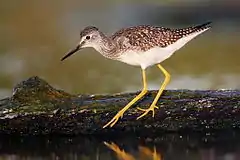Lesser yellowlegs
The lesser yellowlegs (Tringa flavipes) is a medium-sized shorebird. The genus name Tringa is the New Latin name given to the green sandpiper by Aldrovandus in 1599 based on Ancient Greek trungas, a thrush-sized, white-rumped, tail-bobbing wading bird mentioned by Aristotle. The specific flavipes is from Latin flavus, "yellow", and pes, "foot".[2]
| Lesser yellowlegs | |
|---|---|
 | |
| Scientific classification | |
| Kingdom: | Animalia |
| Phylum: | Chordata |
| Class: | Aves |
| Order: | Charadriiformes |
| Family: | Scolopacidae |
| Genus: | Tringa |
| Species: | T. flavipes |
| Binomial name | |
| Tringa flavipes (Gmelin, 1789) | |
 | |
| Synonyms | |
|
Totanus flavipes | |
Taxonomy
This species is similar in appearance to the larger greater yellowlegs, although it is more closely related to the much larger willet;[3] the fine, clear and dense pattern of the neck shown in breeding plumage indicates these species' actual relationships.
Description
The lesser yellowlegs is a medium-large shorebird. The legs are yellow. Compared to the greater yellowlegs, the bill is shorter (visually about the same length as the head), slim, straight, and uniformly dark. The breast is streaked and the flanks are finely marked with short bars.[4]
Measurements:[5]
- Length: 9.1-10.6 in (23-27 cm)
- Weight: 2.8-3.2 oz (79.5-90.9 g)
- Wingspan: 23.2-25.2 in (59-64 cm)
Breeding
Their breeding habitat is clearings near ponds in the boreal forest region from Alaska to Quebec. They nest on the ground, usually in open dry locations.
Migration
They migrate to the Gulf coast of the United States, the Caribbean, and south to South America. This species is a regular vagrant to western Europe; in Great Britain about five birds arrive each year, mostly between August and October,[6] with the occasional individual overwintering.
Diet
These birds forage in shallow water, sometimes using their bill to stir up the water. They mainly eat insects, small fish and crustaceans.
Call
The call of this bird is softer than that of the greater yellowlegs.

References
- BirdLife International (2012). "Tringa flavipes". IUCN Red List of Threatened Species. 2012. Retrieved 26 November 2013.CS1 maint: ref=harv (link)
- Jobling, James A (2010). The Helm Dictionary of Scientific Bird Names. London: Christopher Helm. pp. 161, 390. ISBN 978-1-4081-2501-4.
- Pereira, Sérgio Luiz; Baker, Alan J. (2005). "Multiple gene evidence for parallel evolution and retention of ancestral morphological states in the shanks (Charadriiformes: Scolopacidae)". The Condor. 107 (3): 514–526. doi:10.1650/0010-5422(2005)107[0514:MGEFPE]2.0.CO;2.
- Scott, Shirley L., ed. (1994). Field Guide to the Birds of North America (2nd ed.). The National Geographic Society. pp. 114–115, 137. ISBN 0-87044-692-4.
- "Lesser Yellowlegs Identification, All About Birds, Cornell Lab of Ornithology". www.allaboutbirds.org. Retrieved 2020-09-27.
- "Leser Yellowlegs (species profile)" at the Natural Lizard website (retrieved 5 April 2019)
External links
| Wikimedia Commons has media related to Lesser yellowlegs. |
| Wikispecies has information related to Tringa flavipes. |
- Lesser yellowlegs species account - Cornell Lab of Ornithology
- Lesser yellowlegs - Tringa flavipes - USGS Patuxent Bird Identification InfoCenter
- "Tringa flavipes". Avibase.

- "Lesser yellowlegs media". Internet Bird Collection.
- Lesser yellowlegs photo gallery at VIREO (Drexel University)
- Interactive range map of Tringa flavipes at IUCN Red List maps

